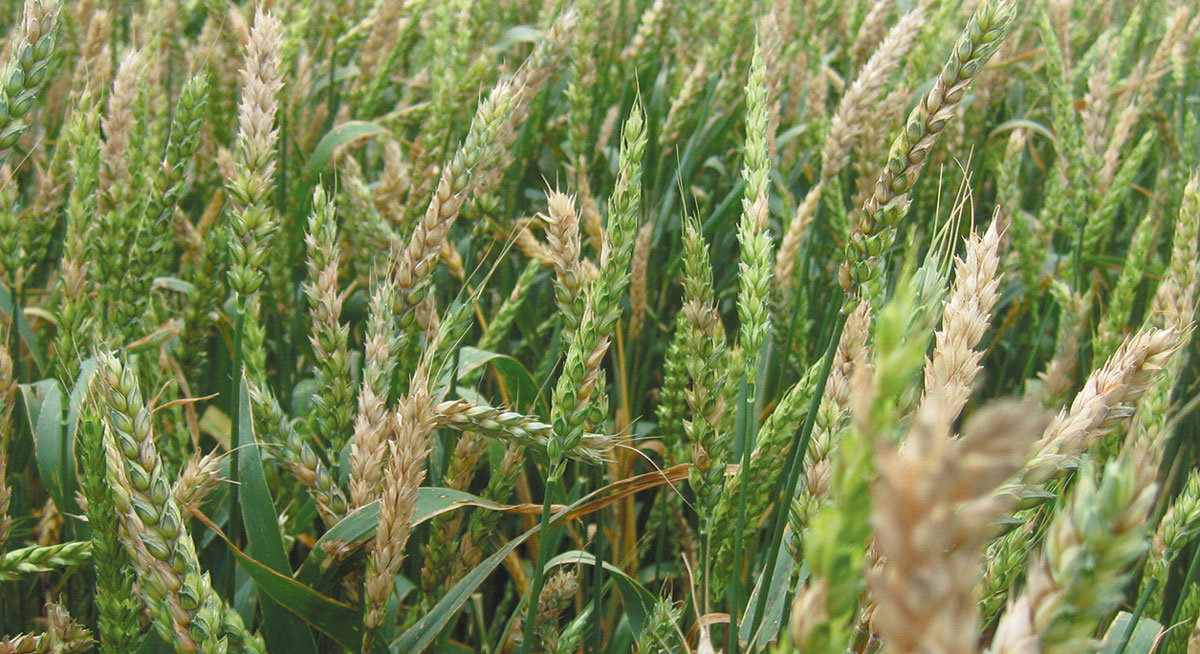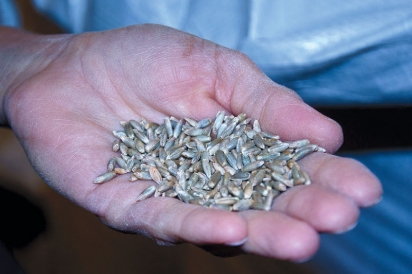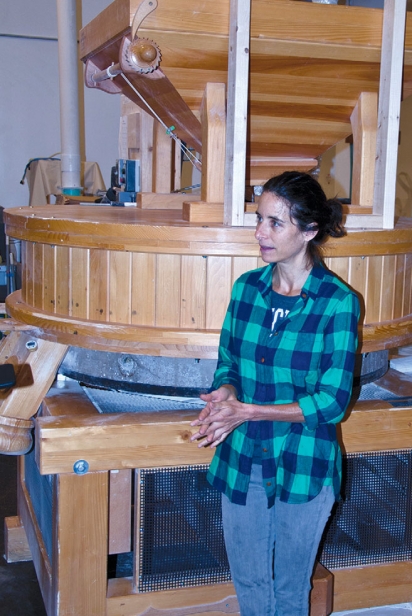Carolina Ground: A Micro Mill
Jennifer Lapidus drives up in a Prius with a bicycle rack on the back and enters a warehouse space with a simple wooden sign beside a steel door that reads farmer-baker-miler.
In the center of the room is a round sleek wooden mill that houses a millstone, not unlike the grist mills of old. She will be running the mill herself today, transferring ton sacks of danko rye from New York and wheats from North Carolina.
Lapidus is a baker who owned a small wood-fired bakery in Marshall, North Carolina for fourteen years. She milled the wheat, stoked the fire, and tended natural leavening. Tired, she was ready to move on. Her journey led her to this mill located in West Asheville and aptly named Carolina Ground. It is part of several mills in New York, California, and now North Carolina that are bringing back micro milling.
For those of us passionate about local food and farming, flour may not be the first thing that comes to mind. For one thing it simply wasn’t available, especially for breads in the south. A new breed of wheat and a new mill changed the way that we can get flour in North Carolina when a plant breeder released new varieties of wheat and a baker with a mission to get flour back in the hands of small business partnered in North Carolina.
A New Wave of Grain
Local bread wheat was never possible in North Carolina until 2009 when a plant breeder for the USDA released two new breeds. Hard wheat for breads didn’t grow east of the Mississippi River.
When David Marshall, USDA plant researcher and professor of plant breeding and pathology with expertise in wheat, moved to NC State University from Texas A&M in 2002, North Carolina flour mills asked him for bread wheat that could be grown locally because they spend a lot of money on transporting the wheat.
Marshall searched and found no seeds “off the shelf ” with good yields, so he began breeding wheats and testing thousands of new varieties to find wheats that grow in high humidity. “It takes about 6 or 7 years to develop a new variety,” said Marshall. “ In the greenhouse, it takes a thousand old-school genetic crosses per year and then selections are grown in seven locations across the state from the mountains to the coast.”
The new wheat was released in 2009. Two varieties, NuEast with a red kernel and Appalachian White with a white kernel, that mills like because the flour is whiter without removing as much of the grain.
What was once impossible, became possible. “We always have more requests for seeds than are available,” said Marshall, whose work has continued with two new wheat breads being released in a few weeks.
Growing Grains
In a typical year, North Carolina grows more wheat than any state in the East. This year has been an exception due to weather. “You have heard of a hundred-year flood, we had a hundred-year crop,” said Dan Weathington, the Executive Director of the North Carolina Small Grain Growers Association.
“Hard wheat is still a rare crop, only about 50 acres,” said Weathington.” Most of it is grown by Billy Carter. Carter raises both conventional and organic foods and supplies mostly locally.”
Other grains of interest include grain used by microbrewers; there are now 163 microbreweries in the state. A local distiller is looking for grains including rye and barley. As demand increases, so will the acreage. “The bottom line is that the farmers need to make money,” said Weathington.
Taking Flour Into Her Own Hands
As a baker, Lapidus had kept up with flour economy. In 2008, the price of wheat was in a bubble, the price went excessively high, and then later busted. Small bakeries couldn’t reasonably pass the high cost to customers. Pricing was determined by commodity traders rather than the market.
“Bakers were disconnected from the most essential ingredient, flour,” said Lapidus, who was concerned about who was controlling pricing. She then heard about testing for a new wheat variety being done by Marshall, and she realized the opportunity to start a mill, the link between farmers and bakers.
“The opportunity to close the gap between farmer and baker presented itself,” said Lapidus, who wrote a grant proposal for the Carolina Organic Bread Flour Project to begin a nonprofit. It was funded by the Tobacco Trust Fund, Golden Leaf, and the Carolina Farmer Stewardship Association. Carolina Ground began as a non-profit until the business could become viable on its own.
The baker who mentored her when she started the mill, Alan Scott, was purchasing a mill in Austria when he suddenly passed away. She purchased the mill instead and Carolina Ground began.
Local milling was not new, rather it was common. Gristmills set along streams and riverbanks. These were later replaced with city mills. You can see the evidence of shuttered mills when you drive through many small southern towns and see rusted silos beside weed-covered railroad tracks. Now, most all supermarket flour travels from megamills in the Midwest, even gourmet brands.
The connection between farmer and baker began when the mill opened in 2012. “We are a baker driven mill,” said Lapidus. “I am able to have a conversation with bakers in the way that bakers speaks. It is a narrative that offers feedback to the mill, a far different approach than for most milling.”
The resulting product is more nutritious and more flavorful because the process is different. Wheat contains three basic parts: Bran (fiber), germ (nutrition/fat), and endosperm (starch). The goal of big industrial mills is to crank out flour without the nutritious germ because the fat goes rancid when flour sits on a grocery store shelf. Most of what is left in supermarket flour is white starch, without fiber and nutrition. That is where enriched flour comes in, vitamin powder is added to the flour stripped of nutrients.
A big departure from this process, the stone mill at Carolina Ground crushes the grain. The mill never heats above 100 degrees, called cold milling, which leaves the enzymes intact. The germ is crushed into the flour spreading its oils, nutrients, and flavor. The flour then goes to a bolter to sift the flour, which removes the larger bran. The resulting flour leaves in the flavor and nutrition.
Carolina Ground Flours are available in 100% whole wheat, the un-sifted flour with everything included. Also, there are choices of sifted and finer flours. Hard wheats for breads, soft wheats for pastry, rye and blended flours are packed and ready to ship to customers: bakeries, restaurants, and home bakers.
The mill supplies flour mostly to the same type of bakeries Lapidus once owned. Flat Rock Village Bakery near Henderson and Smoke Signals Bakery, which is the same wood-fired oven in Marshall that Lapidus once stoked, now is run by Tara Jensen. Local bakeries, LaFarm Bakery in Cary, Loaf in Durham, and Chicken Bridge Bakery in Pittsboro use Carolina Ground.
“I had this idea to take all of our small bakeries and bring them together, where they would be a formable voice and so they could work directly with the grower,” said Lapidus, who admits that hasn’t entirely been the case. Carolina Ground also supplies bakeries in Florida, Cincinnati, and Nashville.
You might notice this flour smells different from supermarket flour, stronger and muskier. The flour feels different in your hands, almost moist. That is because the fat from the germ remains in the flour, a departure from other flour. You can quickly see this flour is different.
The resulting breads are more complex tasting, have more flavor.
Lapidus, and partner David, met through their love of cycling. He is the owner of Village Bakery in Biltmore, a wood-fired pizza restaurant. However, together, they taught a class at the John C. Campbell school. Half of the class used his method and she assisted, while the other half used her method and he assisted.
She no longer has time to bake much at home. Soon, she is traveling with her daughter, who is studying in the UK. “It is hard to keep a starter going if you don’t use it every day,” she explained. “I make waffles if I want to taste the flour because that is a quick way to see how a flour tastes,” said Lapidus.
Carolina Ground Flours:
Whole Wheat Bread Flour is from Hard Red Winter Wheat
Whole Wheat Pastry Flour is Soft Red Winter Wheat
Sifted Flours: Then each type is sifted 85%, 75%, Crema (45%)
They also offer blends of flours and Danko Rye
How to Find Flour:
Weaver Street Market (whole wheat in bulk bins)
Local Bakeries/Restaurants Using Carolina Ground Flour:
LaFarm Bakery in Cary
The Durham Hotel in Durham
Loaf Bakery in Durham
Chicken Bridge Bakery in Pittsboro








